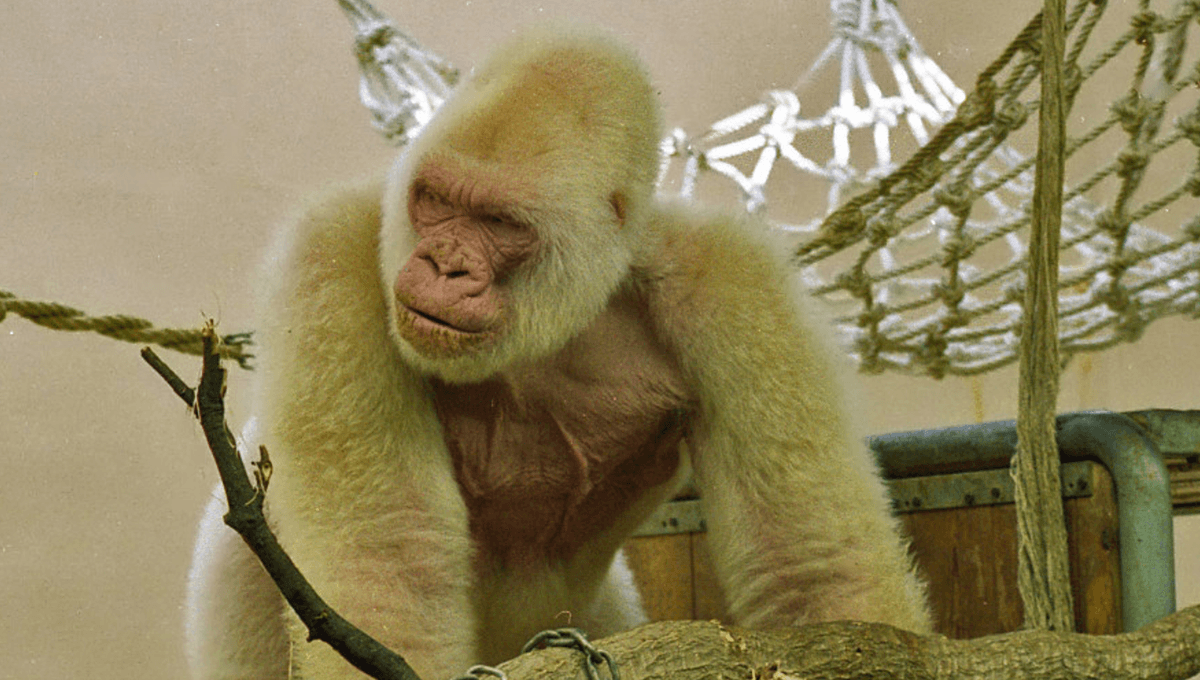
Snowflake was unlike any other gorilla the world had ever seen – or has seen since. With his dazzling white fur, pink skin, and piercing light eyes, he remains the only known albino gorilla in recorded history.
His extraordinary journey began on October 1, 1966, deep in the jungle of Nkó, Equatorial Guinea (then known as Spanish Guinea). Frustrated farmers had shot a mother Western lowland gorilla (Gorilla gorilla gorilla) that was eating their banana and coffee crops, only to find she was still cradling an infant – a snow-white one.
The stunned locals took the unique individual back to their village and named them “Nfumu Ngui” (“white gorilla” in the local Fang language). Within just a month, he was purchased by Jordi Sabater Piand, a renowned Spanish primatologist, and transported to the Barcelona Zoo. Here, he became known as “Copito de Nieve” (“Snowflake” in Spanish) or “Floquet de Neu” (Catalan for “little snowflake”).
When he was revealed to the public in December 1966, his unusual appearance sparked widespread fascination, eventually landing the cover story of the March 1967 edition of National Geographic with the headline “Snowflake, the world’s first white gorilla.” The article, along with a flurry of other media appearances, catapulted him to international fame, making him something of a minor celebrity.
Snowflake was diagnosed with non-syndromic oculocutaneous albinism, a genetic condition that stops cells from being able to produce melanin, a pigment that would normally give an animal its color. Along with causing white hair, pale skin, and red eyes, albinism can result in problems with eyesight. It is inherited in an autosomal recessive manner, meaning both parents must carry a copy of the mutated gene for their child to be affected.
In 2013, scientists at the Institute of Evolutionary Biology in Barcelona sequenced the genome of Snowflake to identify the genetic cause of his albinism. They ultimately found there was significant inbreeding within his gene pool, which increased the likelihood that the offspring would have albinism.
One of the researchers commented that the most likely scenario was that Snowflake’s grandfather carried the recessive albinism gene. Two of his descendants later mated, resulting in Snowflake inheriting both copies of the gene and expressing the rare trait.
During his tenure at Barcelona Zoo, he gained a reputation for being “disdainful and grumpy,” and was reportedly treated with “anti-depressants” for some time. However, his bad temper clearly didn’t damage his libido. He fathered at least 21 offspring with three different females and had several grandchildren.
Unfortunately, Snowflake’s condition eventually caught up with him. He passed away in 2003 in his late 30s, which is pretty good going for a gorilla. They can live to 35-40 years in the wild and up to 50 in captivity.
The cause of death was a rare form of skin cancer, almost certainly linked to his lack of pigmentation. Individuals with albinism are highly susceptible to skin cancer due to a lack of melanin, which protects skin from the sun’s harmful ultraviolet radiation.
While Snowflake remains the only known albino gorilla, he’s not the only albino great ape ever documented. There’s also Alba, the world’s only recorded albino orangutan. After spending part of her life in captivity, she now lives freely in the jungles of Borneo.
Source Link: The Wild Life Of Snowflake, The Only Albino Gorilla Ever Known